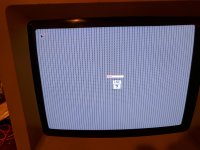techknight
Well-known member
I have an SE/30 motherboard here that belongs to someone else.
It had a strange issue. it had black lines jumping around coming and going. UE8 was already changed and some other ICs swapped around by someone else.
All the PALS are soldered in place, NO sockets! which that sucked.
So, I decided to heat the PCB up and the jumping stopped, but it gave me a black line every 8th video bit. So i decided to buzz out all the connections to UE8, the PALs, and the VRAM muxes, all are OK.
Then I decided to try the freeze spray approach. Hitting UG7 with freeze spray snapped the picture back in with no lines, no jittering. Perfect.
But, it was a 341-0633 and all my SE/30 parts boards had the 341-0746
So I swapped out the pair, the 0633 and 0635 with the 0746 and 0747.
Well, that stopped the raster from jumping around and the lines from flashing and going. But, my 8th video bit horizontally (like a UE8 failure) is still black and gone.
So I thought, well since the other 2 PALs were the 6XX ones I went ahead and changed those out too so all 4 matched.
Same thing. Its not UE8 because I can remove the ROM and I get zebra stripes with NO black line every 8th bit. So the scanning circuit works. Also towards the end of me screwing with it, I noticed the floppy disk ? icon was showing perfectly fine through the black line, as well as the mouse cursor outline. So its almost like an old arcade machine where the sprites are perfect, but the background has lines!
That tells me its a VRAM write issue. maybe? I tried another ROM, another video ROM, and I sucked out and changed the VRAM and no difference. Even tried a different set of RAM, and tried my dougg3 ROM SIMM and same deal.
This one is definitely got me stumped!
It had a strange issue. it had black lines jumping around coming and going. UE8 was already changed and some other ICs swapped around by someone else.
All the PALS are soldered in place, NO sockets! which that sucked.
So, I decided to heat the PCB up and the jumping stopped, but it gave me a black line every 8th video bit. So i decided to buzz out all the connections to UE8, the PALs, and the VRAM muxes, all are OK.
Then I decided to try the freeze spray approach. Hitting UG7 with freeze spray snapped the picture back in with no lines, no jittering. Perfect.
But, it was a 341-0633 and all my SE/30 parts boards had the 341-0746
So I swapped out the pair, the 0633 and 0635 with the 0746 and 0747.
Well, that stopped the raster from jumping around and the lines from flashing and going. But, my 8th video bit horizontally (like a UE8 failure) is still black and gone.
So I thought, well since the other 2 PALs were the 6XX ones I went ahead and changed those out too so all 4 matched.
Same thing. Its not UE8 because I can remove the ROM and I get zebra stripes with NO black line every 8th bit. So the scanning circuit works. Also towards the end of me screwing with it, I noticed the floppy disk ? icon was showing perfectly fine through the black line, as well as the mouse cursor outline. So its almost like an old arcade machine where the sprites are perfect, but the background has lines!
That tells me its a VRAM write issue. maybe? I tried another ROM, another video ROM, and I sucked out and changed the VRAM and no difference. Even tried a different set of RAM, and tried my dougg3 ROM SIMM and same deal.
This one is definitely got me stumped!
Last edited by a moderator:

